
by Naomi Lubick Wednesday, June 6, 2018
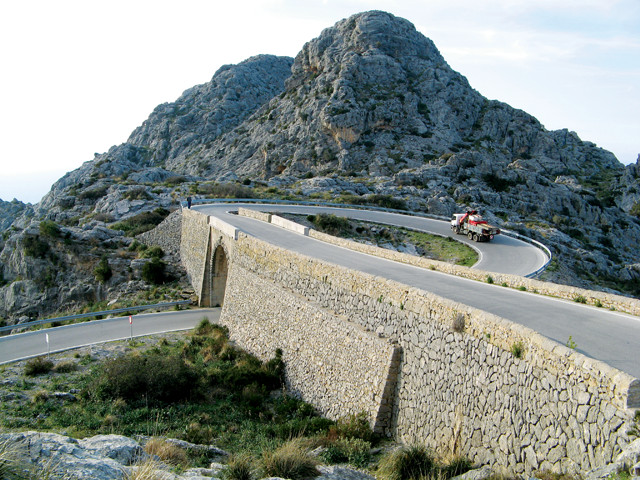
This cloverleaf turn on the winding road down to the mouth of Mallorca's Torrent de Pareis is empty in the off-season. During the tourist season, the road is clogged with visitors who are eager to explore the island's geological history. Credit: Naomi Lubick
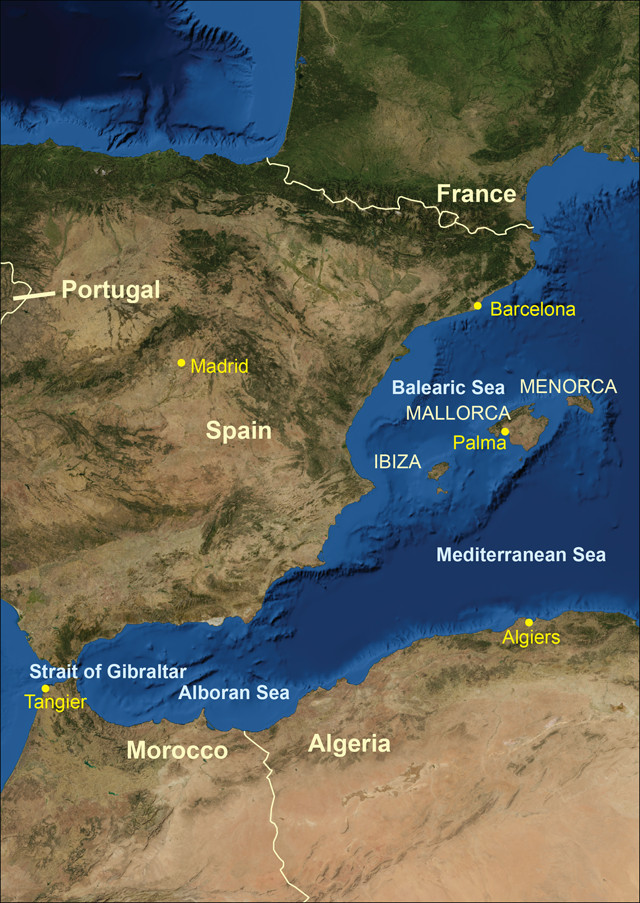
Credit: AGI/NASA
A spring walk along Mallorca’s northern coast yields views of sawgrass, peppered with tiny flowers just beginning to bloom in mauve and white. The stunning blue of the Mediterranean stretches to the horizon, away from the steeply rolling slopes of grass and craggy outcrops. The shore lies several hundred meters below the well-groomed walking trail, and if there is sun shining through coastal clouds, it promises a warmer afternoon after crisp, cool evenings and chilly nights.
A walking tour also provides a view into the geology and history of this Spanish island. Mallorca has been inhabited for thousands of years, and at more than 3,600 square kilometers, it is the largest of the three Balearic Islands that lie about 200 kilometers off Spain’s southeastern shores. Tales of pirates and farmers are part of its past, but its rocks tell even older stories.
Composed of dolomite and limestone from the Mesozoic and Cenozoic (about 170 million to 10 million years ago), the island of Mallorca is bounded by two parallel mountain chains on its northern and southern coasts. Trending southwest to northeast, these mountains arose sometime in the Miocene (20 million to 13 million years ago) as part of the African continent’s collision with Europe. The folded and thrusted ranges are now separated by a younger extensional graben, a low-lying valley formed by the faulting and thrusting around it. Now filled with eroded sediments, the graben flatlands have become a productive agricultural plain.
The higher of the two mountain ranges, the Serra de Tramuntana, runs along the northwestern coast of Mallorca, topping out at about 1,400 meters. Today, what used to be coral reefs have eroded into sharp remnants along the range’s la Ruta de Pedra en Sec — a series of connected walking trails, known as the Dry Rock Route or route GR-221, that runs 150 kilometers over this range.
The climate is dry and hot in summer and wetter and colder in winter, but the environment here is welcoming, as is the culture.
Mallorca’s Wild Side
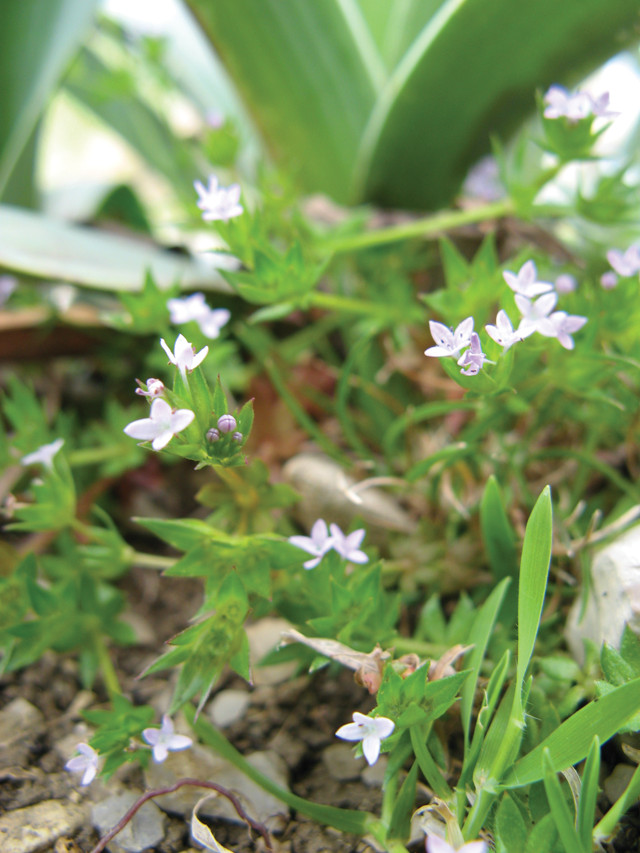
In spring, mauve and white flowers bloom along Mallorca's walking trails. Credit: Naomi Lubick
People in Mallorca and the other Balearic Islands speak Catalan, a Romance language that can seem like a mix of Spanish, Portuguese and Italian, with a little Czech spelling thrown in. Once a temporary home to the Polish composer Frédéric Chopin (and his lover, the writer George Sand, who wrote about the island) and now a summer vacation destination of the Spanish royal family, the island boasts seafood restaurants, unique fashion boutiques and historic sites flooded by tourists. The street signs and stores tend to advertise in Catalan, Spanish and German (and sometimes English).
Last April, I arranged to meet a biologist preparing to do fieldwork in the island’s northwestern region. I flew to the island’s central city, Palma de Mallorca, located on the southern coast, the day before our appointment, allowing for an opportunity to prowl the alleys and cobbled streets of the city.
Because Palma is the provincial seat of government, the Consell de Mallorca is here, as is a magnificent Gothic cathedral built on an older Arab mosque. The Cathedral of Santa Maria of Palma mixes the two architectural styles, as do many Moorish Spanish structures on the island and mainland Spain. The cathedral also houses old and new artworks commissioned for its walls. I passed an ancient Arab bath, a nunnery and the garden of a Catholic bishop, all still functioning and open to visitors.
Despite the lure of baths, history, fashion and food, I was itching to get out into the countryside. My companion rented a car, and we were ready to go by midmorning. We hopped on the freeway and headed northeast before turning north toward the Serra de Tramuntana.
After a midafternoon beer in a small town plaza, we followed a winding two-lane highway that climbed into the mountains, passing through ecosystems that changed from deciduous to evergreen trees the higher we traveled. Eventually, we dipped down the other side and stopped at a biological research station, Son Amer, run by the Environmental Council of Mallorca, a local government organization.
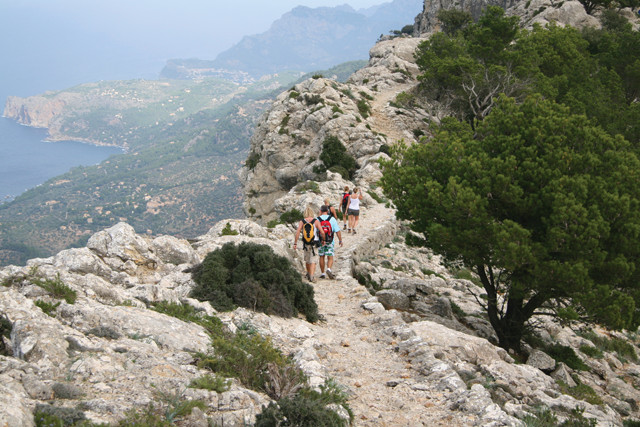
Hikers traversing through the Serra de Tramuntana mountain range, which lies along Mallorca's northwestern coast. Credit: ©iStockphoto.com/Marcus Desaunois
Near the town of Lluc, the station doubles as a teaching center for schoolchildren. It also can be reserved for private hiking groups. The twisted trees and semi-desert landscape reminded me of California’s foothills, with its scrub vegetation and smooth-barked madrone trees that thrive in a similarly dry terrain.
In this high terrain, goats that were introduced when humans first came to the island thousands of years ago have taken over the steep hillsides. They are not the only problematic intruders: Across the island, feral cats, succulents such as ice plants and other non-native species have proven problematic for the frogs, snakes, lizards, birds and other animals and plants that evolved with traits specific to Mallorca.
The Balearic shearwater, for example, a gray gull-like bird that breeds in a protected wetland on northwestern Mallorca, is listed as critically endangered on the IUCN Red List. The local island government has pledged to protect these seabirds as well as other species by maintaining nature reserves and volunteer programs to track, protect and even reintroduce some animals and plants once endemic here.
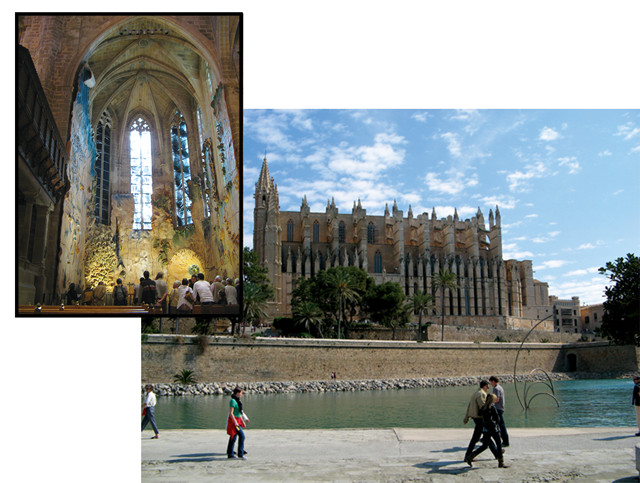
The Cathedral of Santa Maria of Palma is a Gothic cathedral built on an older Arab mosque. The cathedral displays 3-D murals by Miquel Barceló, a modern Spanish artist. Credit: Both: Naomi Lubick
The hike we would take the next day traveled in close proximity to threatened native black vultures. In fact, a ranger warned us that the trail might be closed because a pair had nested on the path. We never saw the nesting birds, only their companions soaring overhead.
We had dinner that night in a small town nearby, which amounted to a few restaurants clustered outside the Lluc Monastery, Sanctuari de Lluc. We tried the local food: dishes made with the meat of mountain goats that thrive here. (Even on an island, my companion said, it is best to eat fish at the shore and meat in the mountains.)
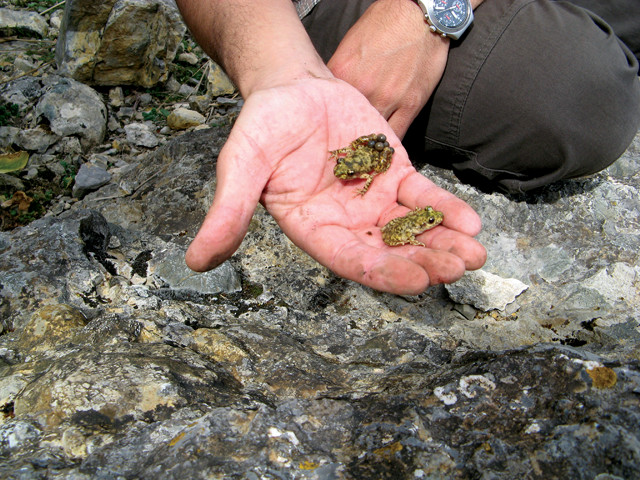
Biologists are studying Mallorca's endangered midwife toads (which are actually frogs). The spread of chytrid fungus — which was brought to Mallorca by captive-bred frogs that were released on the island — threatens to wipe out these amphibians. Credit: Naomi Lubick
Rocky Trails
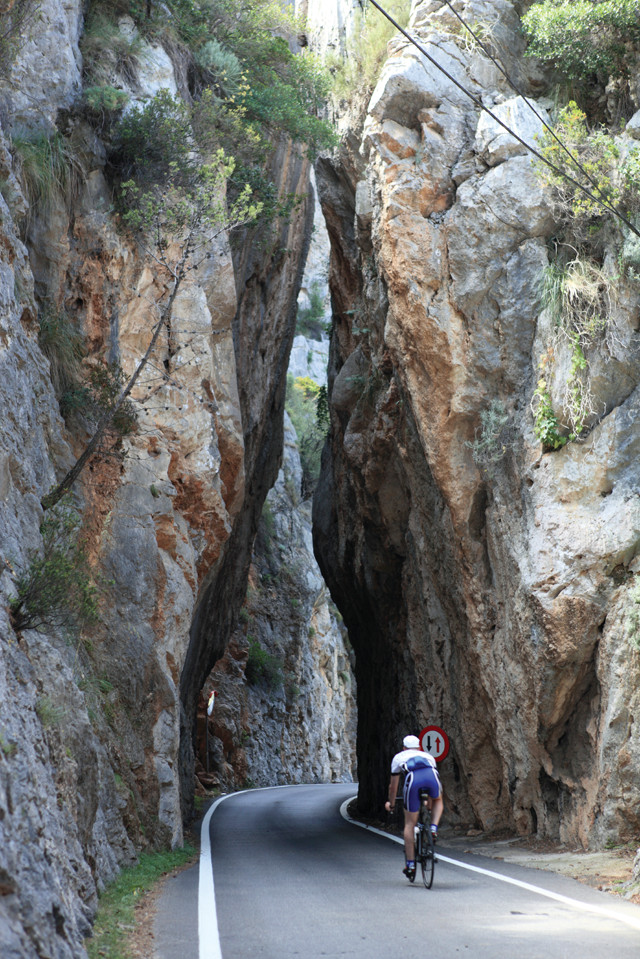
A road in the Tramuntana Mountains, in close proximity to Torrent de Pareis. Credit: ©iStockphoto.com/bitbeerdealer
The next morning we started our hike down a coastal trail that parallels the Dry Rock Route, skirting the coastline northeast of Lluc on the way to Pollença. We began at an old army barracks, known as the Quarter des Carabiners, once used to watch for smugglers of contraband, sailing presumably from African shores to Spain. Nearby, a string of farmhouses, known as Es Cosconar, offers a lovely view of olive orchards in the valley below. These now-empty homes, built for a “finca,” or farm, are not freestanding, but are tucked into natural caves in the carbonate rocks.
Mallorca’s caves have drawn geologists here for their unique climate records in a temperate zone. The karst caves in the southern part of the island in particular mark changes in sea-level rise; their slow-growing speleothems (cave formations such as stalactites and stalagmites) capture isotope ratios as they build, layer by layer, like tree rings. Recent findings here show that during a warming period 81,000 years ago, sea level sat about a meter higher than the present-day Mediterranean, pinning down controversial estimates that ranged from less than 3 meters to more than 30 meters. The researchers say their data demonstrate that sea level changed by 15 meters within 1,000 years — which supports a contentious finding that ice sheets could grow much faster than previously thought.
Erosion has also carved out Mallorca’s surface: The many “torrents,” or streams, of the northern mountains have created a landscape of deeply incised canyons. The torrents flood in the rainy season, which starts in earnest in October and lasts through the winter, and the ephemeral flows can have extreme effects on the carbonate rocks here.
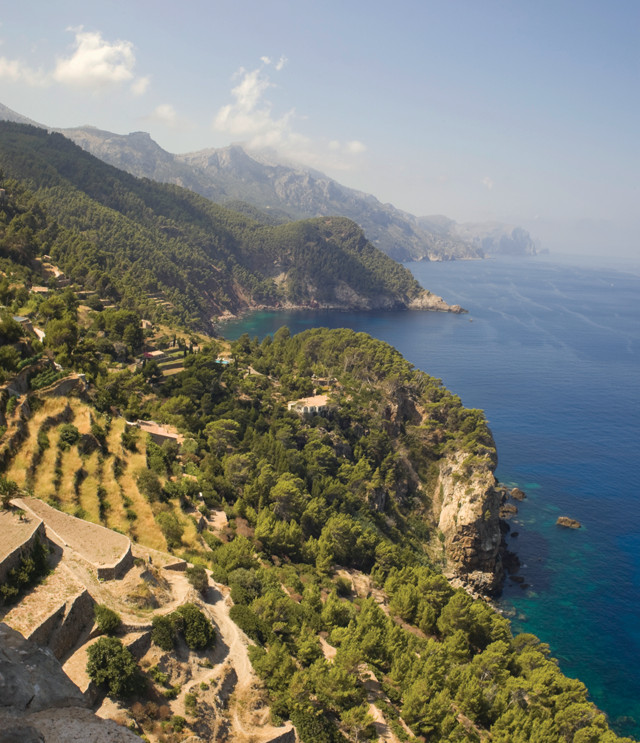
A view of the Serra de Tramuntana mountain range from the top of Mirador de ses Animes, a centuries-old watchtower. Credit: ©iStockphoto.com/rachel dewis
The Torrent de Pareis, the largest stream on the island, has created a beautiful canyon, several hundred meters deep in some spots, that starts high in the Serra de Tramuntana. During our trip, we snapped photos of the top of the torrent at a rest stop, and then drove down a winding road to its mouth, where the canyon opens into a broad, sandy floodplain before its walls narrow again just before reaching the Mediterranean. The bottleneck here supposedly creates fantastic wave forces, but as we were there in spring, it was empty of water. In summer, tourists flock here to take a dip in the sea in the bays nearby. More recently, tourists have come to this part of Mallorca for torrent jumping. A new fad sweeping Mallorca’s many canyon-like streams, torrent jumping is presumably a lot like bungee jumping into a waterfall. (I didn’t try it.)
Although we drove down to the mouth of the canyon, we could have walked to it. The walking options in this part of Mallorca are many, both short afternoon hikes and a string of longer excursions that can leapfrog from beginning to end of the Dry Rock Route at a visitor’s convenience, with hostels located along the way.
The Lluc Monastery serves as a jumping-off point for several of these trails and would make a good home base. The oldest portions of the monastery date to the 1200s, and the hostel at its heart was once a hospital to the people who farmed this region. Sitting in the old cathedral’s inner courtyard, I thought of the even older rock walls abutting the monastery outside. The carbonate cliffs and ancient mountains serve as a reminder of the different forces that shape this island and its culture.
© 2008-2021. All rights reserved. Any copying, redistribution or retransmission of any of the contents of this service without the expressed written permission of the American Geosciences Institute is expressly prohibited. Click here for all copyright requests.